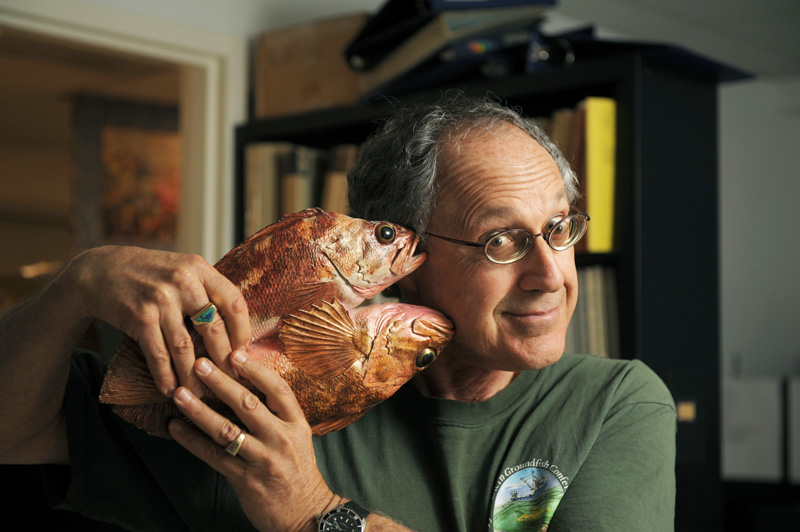by Michael Bear
Best known for his in-depth studies of bocaccio and the rockfish of the Northwest, as well as for his research on the impact of offshore oilrig drilling platforms on local ocean ecosystems, Dr. Milton Love is a research biologist at the Marine Science Institute at University of California, Santa Barbara. He is well known among many Southern California divers and has a fond and nearly cult-like following among those he has worked with, who affectionately address him as Uncle Milty, and who frequently ask him for help in identifying obscure rockfish.
He is also known for his humorous writing style in Probably More Than You Want to Know About the Fishes of the Pacific Coast, and its second edition, Certainly More Than You Want to Know About the Fishes of the Pacific Coast, which, as more than one wag has observed, feels like learning about marine biology from a stand-up comedian.
On an unusual day when he wasn’t diving in a two-person submarine to peer at deep-water species of rockfish, he agreed to an interview with California Diver Magazine.
CDM: You are best known for your work with rockfish—the olive rockfish, in particular—and are asked about them all the time. So, let’s talk about something else. What did you learn in your analysis of the Santa Barbara Inshore Partyboat Sportfishery as a Sea Grant trainee?
ML: That was a fun time. I rode aboard the same partyboat every week for about three years, measuring and identifying every fish that was brought aboard. It was better than working for a living. One thing that was very apparent was how important the oil platforms were as a fishing ground for that vessel. Literally, thousands of fishes, mainly rockfishes, were caught by passengers and virtually all of those fishes were juveniles. Clearly, these platforms were serving as nursery grounds for at least some rockfish species.
When I wrote up my findings, I forgot to include a couple of observations I made in that study: 1) The swim bladder gas of bocaccio tastes different from that of any other rockfish, and 2) it is possible to accurately identify and measure fish when you are stoned.
CDM: Don’t worry. We know you didn’t inhale. So, you’ve also studied the impact of oilrig platforms as artificial reefs on various fish species. As you know, there are several live oilrig platforms near Long Beach that are popular destinations for divers and underwater photographers. Is the impact of oilrig platforms on marine life, overall, a positive one?
ML: Well, it kind of depends of what a person’s definition of “positive” is. If you think that artificial habitat that harbors millions of invertebrates and, often, hundreds of thousands of fishes, is a good thing, then there is likely very little downside to having platforms off Southern California. However, if you, like at least some people I have met, believe that any artificial habitat in the ocean is inherently bad—that only natural habitat should exist in the ocean—then platforms and the animals associated with them should not be there. It is more of a sociological question than a biological one.
CDM: In Certainly More Than You Want to Know About the Fishes of the Pacific Coast: A Post Modern Experience, you cover the Hexanchidae family of Elasmobranchs, or sharks, which includes sixgill and sevengill sharks. Over the past four years, there have been documented reports, via divers’ video and photos on the Shark Observation Network that sevengill sharks (Notorynchus cepadianus) seem to be congregating at a shallow kelp forest near La Jolla Cove. Without knowing anything else, can you venture an educated guess as to why this might be happening?
ML: Goodness, all my guesses are educated. I do have a PhD, after all, which gives me a license to speculate.
In general, when animals congregate (not school, but just loosely associate with each other), there are several possible reasons, and these can be lumped into, perhaps, two categories: 1) they are interested in each other, or 2) they are interested in something else in the environment. If they are interested in each other, then that usually has to do with mating. If they are interested in something(s) in the environment, for a sixgill or sevengill that might include A) temperature—maybe they like it in the cove area, B) food—maybe there is more in the cove area than in the surrounding environment, C) water clarity— maybe the water clarity is better (or worse) in the cove than in other areas and fits with the physiological needs of that species, or D) other aspects of the cove—such as the amount of water movement through swells or currents, for instance.
Now, if this phenomenon of congregating in the cove is a new one, in other words if sixgills or sevengills were not seen or were rarely seen before that, then an interesting question would be why are there more sightings now than in the past? The answer to that is harder to come by, perhaps. The possibilities are: 1) they were always there but folks did not observe them, 2) there are more of these fish in the area, say Southern California, than in the recent past (recent because, say, sixty years ago, there were fewer divers around looking for these animals). Also, since inshore gill netting was banned several decades ago, there is evidence that several targeted species, like leopard sharks, have increased in abundance. 3) It is also possible that this increase in abundance is due to somewhat random events. Fishes may change their favored areas over time, due to factors that are difficult to understand, and it is possible that sometime in the future, these cove congregations will not be as evident.
CDM: Several years ago, in the summer of 2009, and to a lesser degree last year, some California beaches were inundated with visits from the large, predatory Humboldt squid. Scientific speculation as to the reason has ranged from following hake, a favorite prey, to climate changes, and/or changing ocean currents. What do you say? Will they be back?
ML: I think so. Whether the increased numbers of Humboldt squid are due to any single factor is unclear, but there have been enough recent years of abundance of these animals along the Pacific Coast that it definitely looks like more than a one-shot phenomenon.
CDM: What would you say is the main reason that the California sheephead changes sex? Is it solely to balance out male/female population ratios?
ML: Sex change in sheephead appears to be a more complicated affair than in many other wrasses (such as the cleaning wrasses of the tropics) or in such fishes as anemonefishes. In those species, merely removing a large, dominant individual is enough to initiate sex change in at least one of the more subservient fish. However, sheephead seem to take a morenuanced approach to it all. There seem to be multiple triggers—a combination of the density of large males, the age of the females, and, perhaps, other stuff we are not aware of . . . all of these factor into a female’s “decision” to change sex.
CDM: What was it like working with ocean celebrities like Jean-Michel Cousteau and filmmaker Howard Hall?
ML: It was great. I have worked with J-M for about thirty-five years. What I most appreciate is that he does not take himself too seriously. It would be easy for him to fall into the “I am a Cousteau” mindset, but he has not given in to that temptation. Howard is another consummate professional, a pioneer in the field. I wrote the narrative for one of his PBS specials—that one on Cocos Island—and I remember how hard he worked to keep some of the humorous lines I wrote intact, even when he had to fight with the public television station that was footing the bill. For that, he has my undying affection.
CDM: On your website, http://www.lovelab.id.ucsb.edu/, you give famously hilarious advice to would-be marine biologists. What do you tell prospective marine biologists now about their career prospects? Is it still a good career in these economic times?
ML: Absolutely. However, just like in many other fields, you must be dedicated to the craft. What that means is that if you graduate with a degree in some marine science, it is likely that you will not get your dream job right off the bat. Maybe you will have to get a graduate degree first, or maybe you will have to first work in mosquito abatement in Dismal Seepage, North Dakota. But, if you are competent and enthusiastic, eventually you can get to where you want to be.
CDM: How often to you get to dive?
ML: All my diving is in a two-person submarine. I spend one to two weeks a year inside that sub.
CDM: Of course, no interview with you would be complete without at least one rockfish question for you. So, here goes: In Certainly More Than You Want to Know About the Fishes of the Pacific Coast, you say that Narum et al. (2004) classified the gopher rockfish as an “incipient species,” with black-and-yellow (rockfish).” What did you mean by that? That they can interbreed.
ML:There are maybe seventy-five species of our friends the rockfishes on the Pacific Coast. Many species are only a few hundreds to thousands of years old—just a blink of the geological eye. And, in some instances, the process of speciation is occurring right before our eyes. That is the case with gophers and black-and-yellows, which are just barely two species. What that means is that—except for somewhat different colors—there are no physical differences that we can find between the two species. There are very subtle genetic differences, however. When this occurs, and it occurs with a number of rockfishes, including blue rockfish and vermilion rockfish (actually two species), the two species are often called “incipient” because they are kind of in the first stages of breaking apart. And, yes, it is possible that very occasionally gophers and black-and-yellows still interbreed.
Check out Dr. Love’s “Love Lab” at http://www.lovelab.id.ucsb.edu. His books are for sale at http://www. reallybigpress.com


